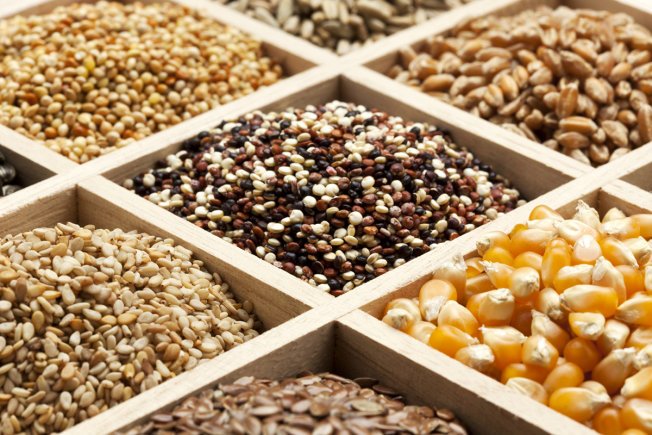
There are so many ancient grains popping up at the market and in restaurants. But have you heard of sorghum, one of the more underappreciated grains? Here’s the history of this gluten-free grain, along with tips for purchasing it – and of course, a recipe to try.
What Is Sorghum?
Believed to have originated in Africa, sorghum is a crop that is tolerant to drought. It survives in conditions where other crops would wither and die. About 50 percent of the sorghum produced in the world is consumed by people, though in the U.S., most of it is used for animal feed or made into biodegradable packing material or wallboard. Kansas, Texas, Oklahoma, Colorado and Arkansas are America’s top five producers of this nutty-flavored grain.
What’s so good about sorghum? It’s nutritious, easy to cook, tasty and more versatile in the kitchen than you can imagine.
The Nutritional Low-Down
One-quarter cup of uncooked sorghum (or 3/4 cup cooked) contains 158 calories, 2 grams of fat, 5 grams of protein, 35 grams of carbs and 3 grams of fiber. Depending on the crop and processing, some varieties can have as much as 5 grams of fiber per 1/4 cup of uncooked sorghum. Whole-grain sorghum is also high in iron, and provides several energy-boosting B vitamins including thiamin, riboflavin and niacin.
This ancient grain also contains several phytonutrients – plant chemicals that help prevent or fight disease – including phytosterols, phenolic acids and policosanols, which may play a role in heart health.
In the Kitchen
Here are the most common ways Sorghum is sold in the U.S. – and ideas on how to use them in your kitchen:
- White pearled-grain sorghum: This type of sorghum has been through a milling process to remove the hull (the outer layer of the grain). Use it in place of rice or pasta, or toss it into salads. Pearled sorghum is quicker to cook than whole-grain sorghum.
- White whole-grain sorghum: This variety has been through the milling process, but the hull has not been removed, making it higher in nutrients like protein and fiber. Use it as a side or toss it into soups or salads.
- Whole-grain sorghum flour: This kind of flour is derived from white or tan sorghum. It’s a gluten-free flour option for baked goods such as muffins, pizza, breads, cookies and cakes.
- Sorghum syrup: Sorghum sold this way has been used as a sweetener in the U.S. since the 1950s. It comes from the juice squeezed from the stalks of certain sorghum varieties. It has a rich, dark color similar to molasses, but with a milder taste. It’s also a good source of vitamin B6 andpotassium, and contains small amounts of calcium and iron. Drizzle it over fruit, waffles, pancakes and yogurt parfaits.
- Popped sorghum: This kind of sorghum looks like miniature kernels of popped corn, but without the hull. It can be eaten as is for a wholesome whole-grain snack.
You can purchase whole-grain sorghum and sorghum products at your local health food store. Here are a few companies that sell sorghum, many of them online:
- Bob’s Red Mill: sorghum grain and sorghum flour
- Wondergrain: whole-grain sorghum, pearled sorghum and sorghum flour
- Golden Barrel: Sorghum syrup
- Authentic Foods: Sorghum superfine flour
- Mini Pops: Air-popped sorghum
Try this Kale, Fennel and Sorghum Salad
Recipe by Tracee Yablon Brenner and Kathy Siegel of Triad to Wellness

In this recipe, you don’t have to marinate the kale, but doing so softens it and adds flavor. Further, marinating kale for a couple of hours (or overnight) prior to making the salad also helps keep the fennel from changing color. A bonus of trying this recipe? The salad is good the following day. The kale will not wilt and the sorghum will not be soggy.
Prep time: 10 minutes
Cook time: 20 minutes
Serves: 4 (as a side dish)
Ingredients:
For the Marinade
- 1 small lime, juiced
- 2 tablespoons olive oil
- Salt and pepper to taste
For the Salad
- 2 cups of kale, finely chopped
- 1/4 small fennel bulb, thinly sliced (with top fronds and bottom of bulb trimmed)
- 1/4 cup yellow pepper, chopped
- 1/4 cup red pepper, chopped
- 1/4 sweet onion, thinly sliced (optional)
- 1 cup cooked whole-grain sorghum (we used Wondergrain)
For the Salad Dressing
- 3/4 cup olive oil
- 1/4 cup red wine vinegar
- 1 tablespoon Dijon mustard
- 1 clove garlic, minced to taste
- 1 small lime, juiced (add half of the lime juice to the dressing, then add lime juice to taste)
- 1 teaspoon honey
- 2 tablespoons fresh basil, finely chopped
- Salt and pepper to taste
Instructions:
1. Make the marinade by whisking together the lime juice, olive oil, and salt and pepper to taste in a medium bowl.
2. Add the kale, fennel, peppers and onion in the prepared marinade and just moisten – don’t drench – the kale. Refrigerate for at least 2 hours prior to serving.
3. Mix the kale, fennel, peppers, onion and cooked whole-grain sorghum in a separate bowl.
4. In a small bowl, whisk together the salad dressing ingredients.
5. Add 1/4 of the salad dressing and toss to combine.
Nutrition information (per 1 cup with marinade): Calories: 337, Total Fat: 55 grams, Carbohydrates: 55 grams, Sugar: 5 grams, Sodium: 68 milligrams, Fiber: 2 grams, Protein: 3.4 grams
Source: Modern America: Meet Ancient Grain Sorghum – US News

